by Alby McInnis, Annika Diaz, Jessica Rousset, David Guston, Ann Kapusta, Benjamin Fernando, Herbert Drayton, Diana Ayton-Shenker, Simon Jackman
The growth of the space sector provides an opportunity for democratization of engagement with significant opportunities for individuals previously excluded due to their gender, ethnicity, background, or abilities. This paper leverages existing studies from inside and outside the space sector to lay out the benefits of Diversity, Equity, Inclusion and Accessibility (DEIA) practices and policies in the space industry, the pitfalls when these policies are wanting, and the ways in which the space sector might usher in a new era of DEIA. The literature shows that companies that implement DEIA practices combined with high-performance work systems see 13.2% greater productivity, 8.8% more innovation, and 8% higher employee retention as opposed to those that do not. While clear evidence exists showing the benefit of promoting equity and inclusion, there is a clear gap in implementation of these policies. Methods to overcome implementation barriers include developing actionable metrics, establishing relevant committees, and instituting professional development that supports underrepresented employees. The paper outlines seven recommendations that will advance DEIA practices in the space industry, including nurturing a positive diversity climate; engaging in dialogue; promoting oversight and accountability; committing to transparency and advocacy; adopting the principles of universal design; investing in education; and tracking actionable metrics. By looking at the progress of both large and small companies across the broader economy that stand out in their DEIA approaches, we offer this framework for individual organizations, particularly those in the space sector, to implement intentional and interactive processes and policies that can effectively advance a DEIA culture. While there are geopolitical and cultural challenges, we must collectively invest in education, upskilling, and mentorship programs that will produce the diverse and qualified workforce that is needed to propel the space industry forward and unlock its promise for those of us who remain on Earth and those who travel beyond.
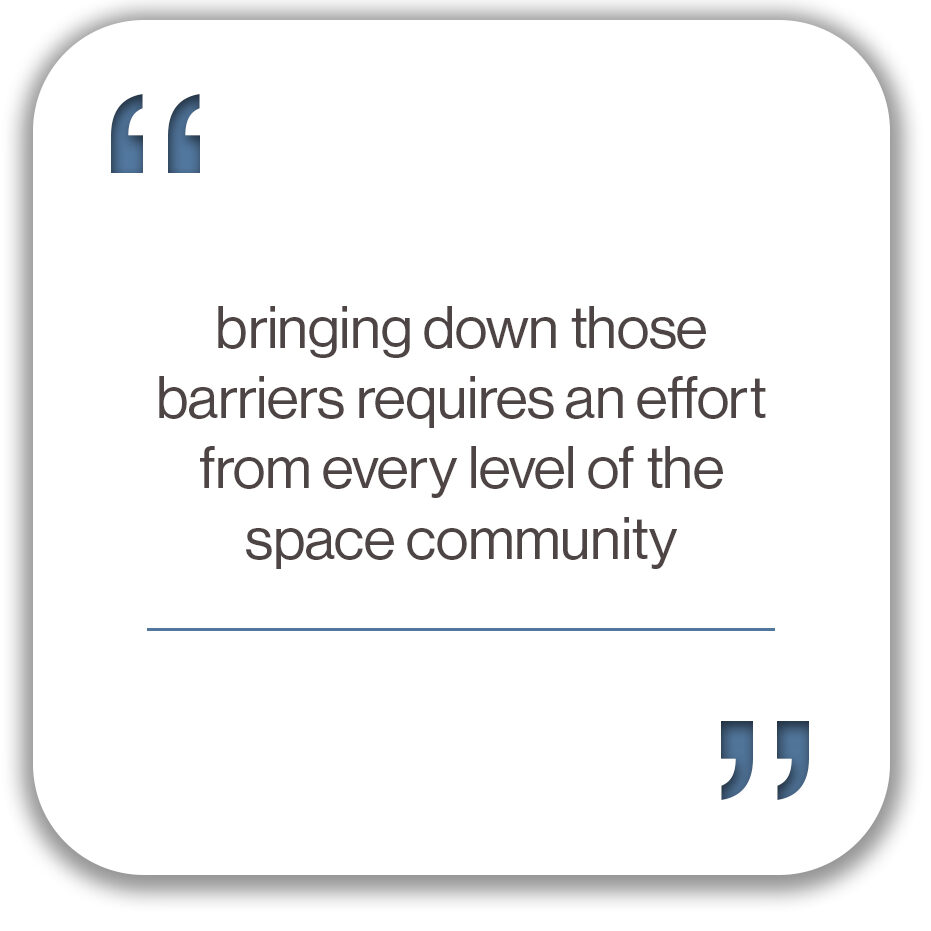
From our research, we have developed a framework of seven recommendations that work as a guide for space organizations and communities to proactively create a culture of diversity, equity, inclusion, and accessibility (DEIA). DEIA is crucial to the future of space and comes with a myriad of benefits to underrepresented and underserved groups, corporations, and society. There are many barriers to effective DEIA, and bringing down those barriers requires an effort from every level of the space community. Within this paper, we aim to identify these barriers and how to bring them down through a framework using interdisciplinary research. This is done through three distinct audiences, including organizational leaders, DEIA implementers, and the broader space community that must work synergistically to effect change within the industry.
Leadership is the foundational element of this DEIA framework. It is imperative that organizational leaders across the space community commit to implementing and monitoring DEIA. It has been shown that leadership is key to effective implementation, as their oversight and guidance are relied upon heavily. While DEIA initiatives may choose to create a separate oversight body for current leaders, the framework proposed here calls for those in leadership positions to spearhead their organization’s approach to removing barriers to DEIA. This not only ensures communication and cooperation between leaders and DEIA implementers, but also creates the optimal conditions for equity, responsiveness, and accountability.
Leaders and implementers should follow a structured framework for designing and implementing DEIA programs that meet their organizational goals and culture. In addition, a roadmap for continued improvement of DEIA initiatives and practices should be pursued. Both a framework and roadmap are provided in this paper. The framework relies on feedback loops between leaders and DEIA implementers, to preserve accountability and oversight. This model of DEIA anchors initiatives in open and responsive communication across the organization and at the highest level. The roadmap provides key metrics to track progress, identify underlying issues, and anticipate challenges to proactively nurture a diverse and equitable culture.
Research shows that advancing a DEIA culture and equitable opportunities increases employee productivity, innovation, and retention. Furthermore, implementing proactive DEIA programs with measurable outcomes can help organizations address conflicts and challenges before they negatively impact the workplace culture. The DEIA framework put forth in this paper is designed for organizations to efficiently build upon existing practices.
This framework for DEIA initiatives is designed to be applicable to organizations across the space sector, and adaptable to each organization’s goals, culture, and growth trajectory. Key to any organization’s growth and embedded in this framework is the establishment and promotion of educational programs that create educational opportunities for underrepresented groups. Furthermore, the concept of universal design underpins the framework, as it ensures building a culture, products, and services that can endure long-lasting change into the future. For the motto “space is for all” to become reality, it is critical the space sector embrace universal design.
Lastly, the framework recognizes that DEIA is an evolving goal, and therefore a broad community of stakeholders must be continually and frequently engaged in the design and redesign of these programs.
Introduction
We have a unique opportunity with the next generation of space travel and exploration to democratize our engagement as a society. Space was once the preserve of government agencies and very few select astronauts who had the chance to experience it. With the exploration domain transforming into a commercial sector—alongside the long-standing communications, positioning, and observation sectors—the leading players can set the agenda and the principles with which this transformation takes place. Engagement across the whole of society, including with those who would never have dreamed of working on space projects, can be made possible along with countries and groups who have been excluded in the past.
While ethnicity and gender have been historical markers of diversity, we consider diversity as including additional categories such as socioeconomic background, religion, sexual orientation, gender identity, age, disability, veteran status, nationality, and intellectual perspective. This white paper lays out the benefits of DEIA practices and policies, explores the pitfalls when these policies and practices are lacking or insufficient, and proposes ways in which the space sector might usher in a new era of DEIA, leveraging existing work from progressive organizations inside and outside of the space sector.
Why DEIA Matters
DEIA practices are not simply a legal safety net, but a means to promote the ideal working environment. We can create a climate of inclusion through comprehensive policy changes combined with better representation of minority groups. Such a climate catalyzes a myriad of benefits for underrepresented and underserved groups, corporations, and society as a whole, including the growth of innovation and increased productivity (Armstrong et al., 2010). Conversely, overlooking DEIA leads to a significant loss of talent and diversity of ideas across all industries (Armstrong et al., 2010). In the context of high-risk space exploration and settlement activities, these effects may be even more consequential and costly, threatening the success of future space missions and operations.
Studies show that companies that implement DEIA practices and initiatives outperform those that do not. Firms that adopted more DEIA practices combined with high-performance work systems saw 13.2% greater productivity, 8.8% more innovation, and 8% higher employee retention (Armstrong et al., 2010). A 2020 McKinsey report also demonstrates this point when looking at how gender and ethnic diversity in executive teams affects performance. Companies whose executive teams comprised 30% or more women were found to be 28% more likely to financially outperform companies with less gender diversity (Dixon-Fyle et al., 2020). Additionally, when an organization is committed to diversity in leadership, it communicates the value of all demographic groups at all levels in the organization, and employees develop a shared sense of reciprocity within a positive climate entrenched in diversity (Choi, 2013; Oberfield, 2016).
Implementing DEIA practices and values creates an environment where employees feel they can positively contribute to organizational performance by communicating unique ideas and reducing stereotypical thoughts (Moldogaziev & Silvia, 2015). Investments in recruiting, training, and mentoring programs in DEIA, and a leadership team committed to these principles, prevent the possibility of a suboptimal environment and support a diversity advantage that enhances decision-making quality (Moon & Christensen, 2020). The diversity climate created by DEIA policies also reduces the distinction between who is included versus who is excluded (Moon & Christensen, 2020). By eliminating this marginalizing mentality, an environment where there is freedom of thought and expression that values the respect and dignity of others can emerge. Ultimately, within diverse and inclusive environments, employee turnover is minimized, interpersonal conflicts are reduced, and employees can work more efficiently and productively without concern over discrimination and hostile working conditions (Armstrong et al., 2010; Moon & Christensen, 2020).
However, this is not easy to achieve, as there are many barriers to successful implementation of DEIA policies.
Barriers to DEIA
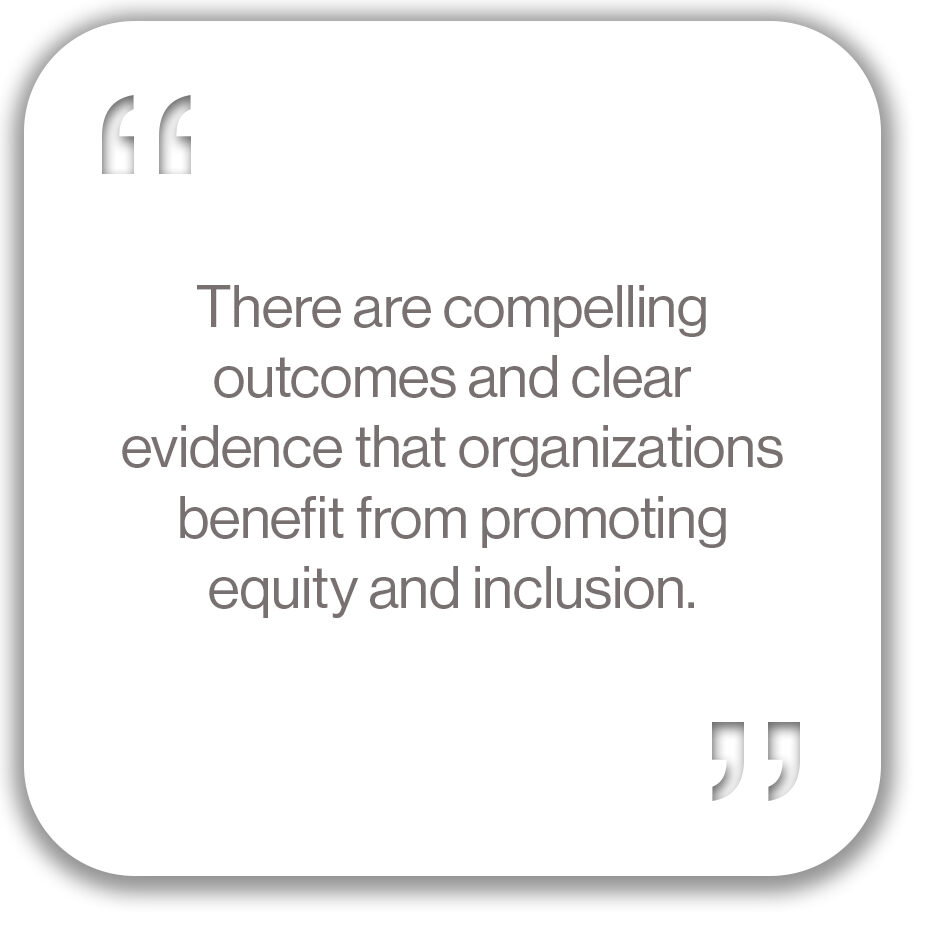
There are compelling outcomes and clear evidence that organizations benefit from promoting equity and inclusion. However, according to a PwC multi-year, global, cross-industry survey, only 4% of those reporting are succeeding in key dimensions of successful DEIA programs (PwC, 2022). Many programs are in their infancy, and there remains a gap between DEIA efforts as perceived by employees and what organizations are implementing (PwC, 2022). For example, only 61% of women employees felt their companies were making gender diversity a priority, versus 87% of companies stating they prioritize gender diversity (Dixon-Fyle et al., 2020). This is particularly troubling when looking at the retention of younger employees. In a global study of Millennial and Gen Z employees, it was found that 52% of employees left within two years if they found the company’s progress toward an inclusive and diverse work environment unsatisfactory (Deloitte, 2022).
This disconnect between employees and leaders may stem from diverging perceptions of how frequently DEIA is communicated, whether or not affinity groups are included in strategic priorities, and what actions are taken to tackle unconscious biases.
DEIA practices that encourage underrepresented groups throughout their educational journey are also lacking. Large losses occur early in the academic pathways of STEM students, with some students finding STEM inaccessible as early as 5th grade (Grossman & Porche, 2014). According to a Pew Research Center report, most minorities lack access to quality education, encouragement to pursue subjects at an early age, and role models working in the field (Funk & Parker, 2018).
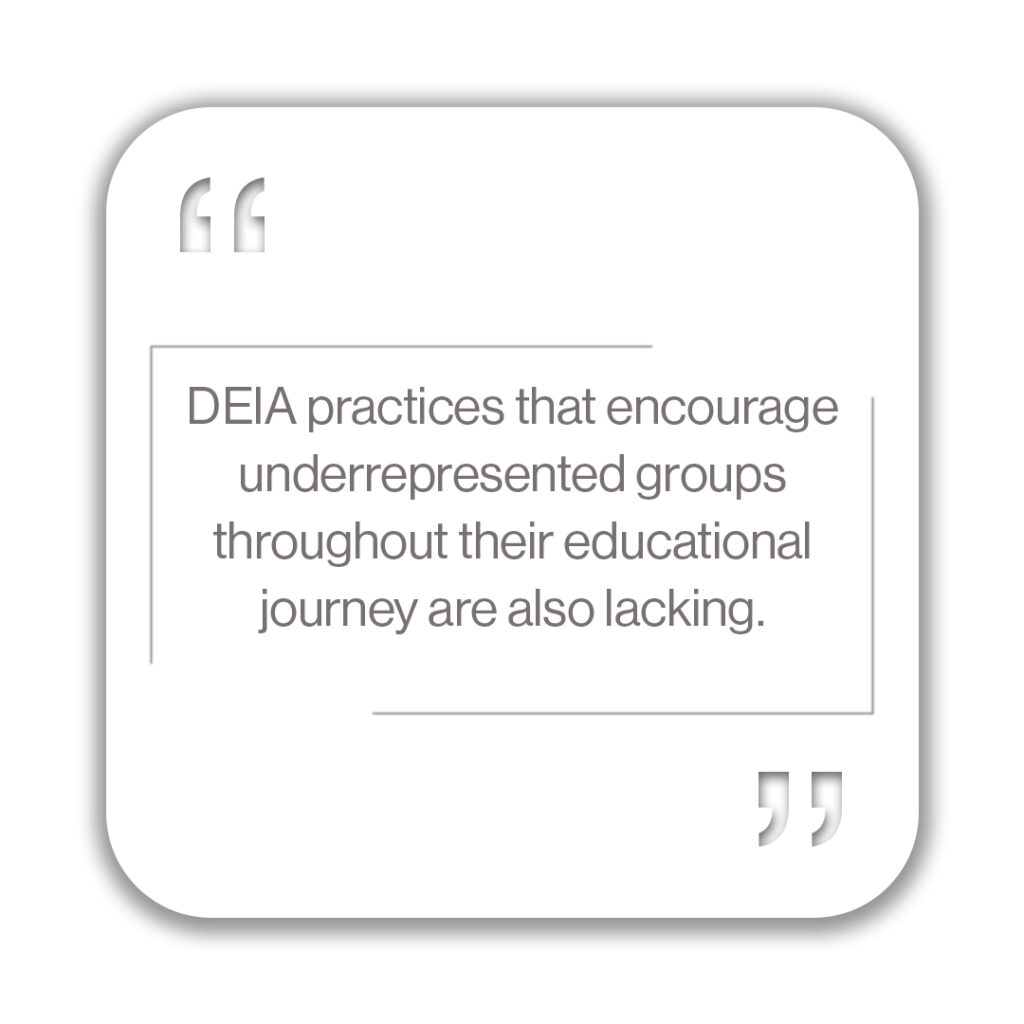
This is particularly stark when considering minority representation in the STEM field. Hispanic and Black employees represent only 17% of the STEM field, despite making up 28% of the general workforce (Fry et al., 2021).
For software engineers, for example, a strong association was found between early exposure to computer science and early career opportunities (Burge et al., 2021). Unfortunately, research suggests that Black high school students are less likely than White students (47% vs. 58%, respectively) to have classes dedicated to computer science (Burge et al., 2021).
Despite Hawaii having one of the most important space telescope assets in the world on Mauna Kea, only three Native Hawaiians have received a PhD in astronomy over the past 50+ years of available statistics (National Academies of Sciences, Engineering, and Medicine [NASEM], 2022). Similarly, African Americans receive an average of only one PhD in astronomy per year (NASEM, 2022).
Research funding programs have a major influence on the economic stability and social capital of individuals receiving grants in academia. A recent study has shown that the National Science Foundation (NSF), a major funder of research in the United States, contributes to pervasive racial disparities by consistently funding white researchers at higher rates than non-white researchers (Yifeng Chen et al., 2022).
Other driving causes for these outcomes were found to be that mentor / mentee relationships can result in minimal support or, in some instances, outright hostility (NASEM, 2022). Often mentors are of a different ethnicity, religion, socioeconomic background, etc. than their mentees; the lack of diversity in the STEM field makes it difficult for mentors and mentees to connect and create an effective relationship (NASEM, 2022). In some cases, the lack of diversity and options for mentors forces mentees to be stuck in toxic mentor-mentee relationships, and can cause mentees to leave the field altogether (NASEM, 2022)
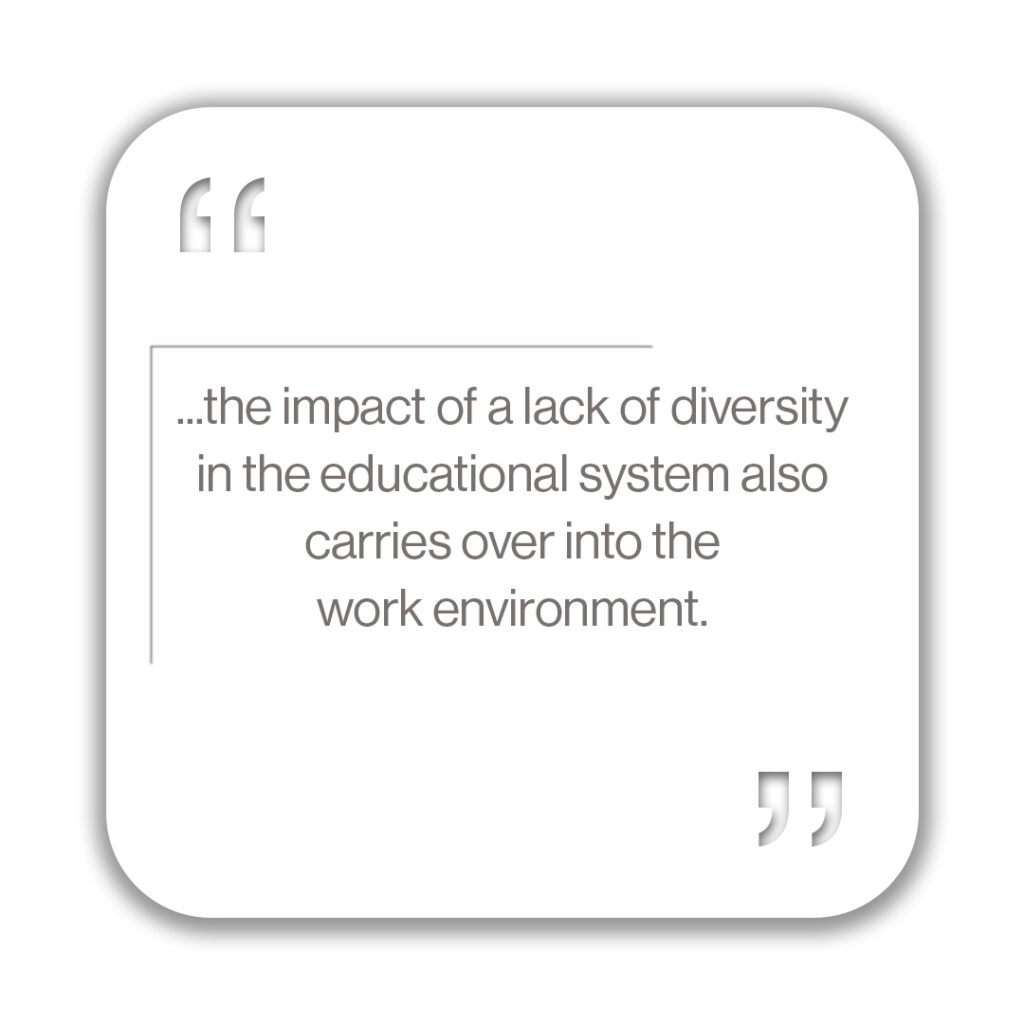
We see that the impact of a lack of diversity in the educational system also carries over into the work environment. In a survey of those working within the physical sciences in the United Kingdom and Ireland, 30% of respondents witnessed discriminatory or exclusionary behavior in the workplace (The Institute of Physics et al., 2019). In the same 2019 survey, 28% of LGBTQ+ respondents considered leaving their workplace at least once due to discrimination or the negative working climate surrounding LGBTQ+ individuals (The Institute of Physics et al. 2019). For people of color working in STEM within the United States, 57% say that their organization is not doing enough to foster a DEIA workplace; conversely, only 15% of white people agree (Funk & Parker, 2018).
In addition to systemic racism at academic and research institutions, there are many examples of racism and sexism in the space industry. Within the last few years, organizations such as SpaceX have seen several allegations of sexual harassment, sexism, and racism (Sheetz, 2021). These problems are seen within the United States Space Force and Air Force as well, with one study finding that as much as one-third of female service members have experienced sexual harassment (The Inspector General of the Department of the Air Force, 2021). Despite many quantitative studies describing hostile work environments with very public examples of harassment and bias in both the commercial and public space sector, companies and organizations are finding it challenging to identify what constitutes a DEIA-supportive environment. Many companies are finding that the current practices developed in the late 60s are not leading to increased diversity, but hurting diversity instead (Dobbin & Kalev, 2016).
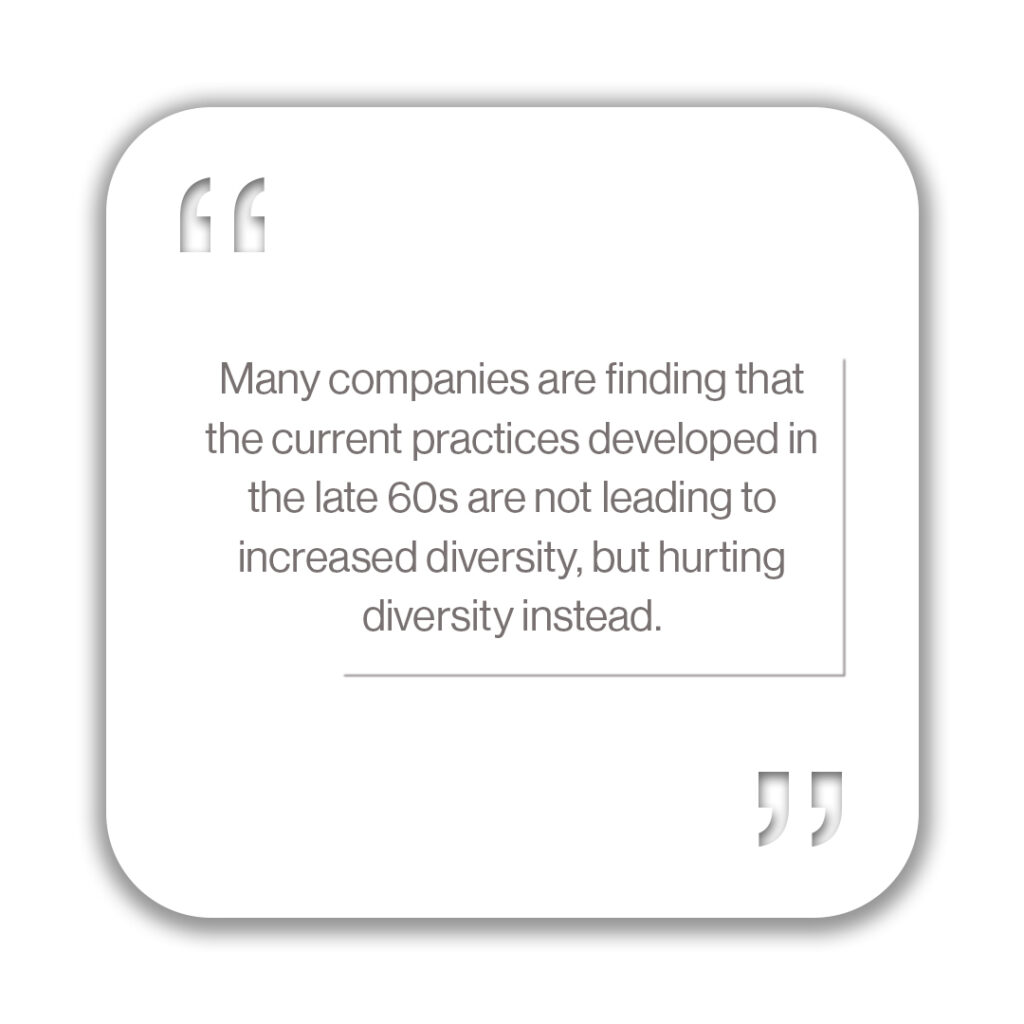
Addressing Barriers to DEIA in the Space Sector
Universal Design
In the space sector, the need for a diverse crew will be key to the success of deep space missions, commercial space stations and long-term settlements of other planets. Universal design allows for significant fault tolerance and redundancy of mission-critical systems. For example, Chris Hadfield went blind temporarily during his 2001 spacewalk on the International Space Station (Wells-Jensen, 2019). He mentions his thought process in a 2014 TED talk, saying “Okay, I can’t see, but I can hear, I can talk…” By using his other senses, he was able to work through his blindness and complete his mission. Had universal design been built into the system, redundancies would have existed to avoid issues with his temporary disability.
Following universal design principles to accommodate more diversity in space, particularly as it relates to disability, is not a new idea, as papers as far back as 1997 discussed how universal design for spacecraft and equipment leads to less operation error and promotes efficiency (Blume, 1997). Designing space hardware and software for diversity not only allows participation to transcend stereotypes but will be key to stimulating broad participation in the space economy. While space can be a particularly challenging environment in which to incorporate universal design elements due to size, space, and weight limitations of spacecraft, there are elements of universal design principles that can be implemented when establishing policies and practices for DEIA in the space sector and beyond.
A Global Challenge
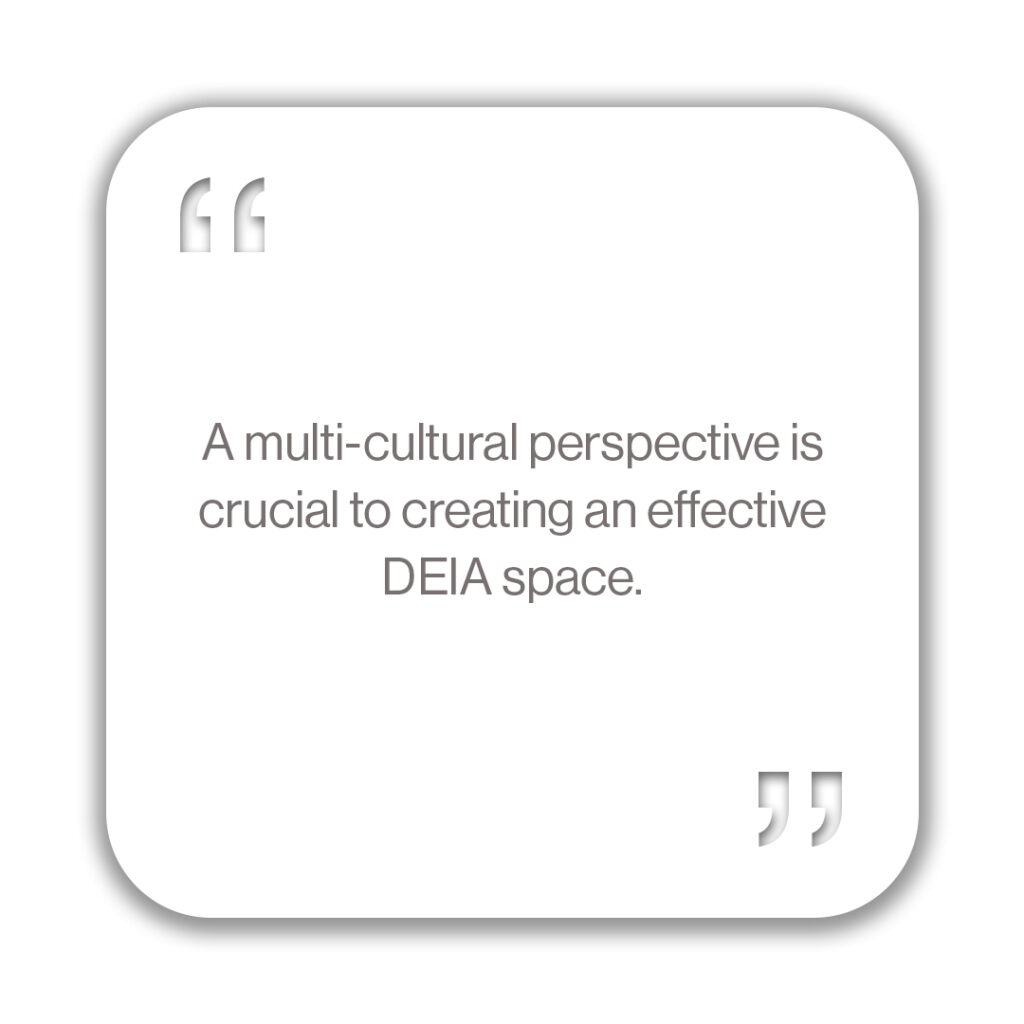
Our human endeavors in space engage stakeholders from around the globe. Thus, our institutions and organizations need to incorporate political and cultural differences from across the globe. DEIA policies can look different from policies in the Western world. Decolonization and indigenization bring forth issues that deepen the common categories of marginalization such as race, sexuality, age, gender, and ability. Bringing in multiple perspectives is crucial to creating an inclusive environment that is not focused only on developed/industrialized nations, but as many nations as possible.
We may consider the benefits of the global framework called KLOB (Knowledge exchange, Language, Obligations, and Biases), which considers the intersectionality of DEIA as well as the cumulative effects of the multiple barriers people experience (Khelifa & Mahdjoub, 2021). We can better advocate for DEIA when we consider the accumulation of “KLOB” barriers many individuals experience, especially by those coming from a non-English speaking background. A multi-cultural perspective is crucial to creating an effective DEIA space.
Programs that Improve DEIA for the Space Sector
Both public and private space sector organizations are beginning to explore opportunities that encourage and promote greater DEIA policy implementation through the creation of specially targeted programs. For example, NASA’s SMD Bridge Grant focuses on creating sustainable partnerships utilizing collaborative mentorship programs between NASA scientists and engineers in conjunction with students and faculty at historically under-resourced institutions. The Minority University Research and Education Project (MUREP) from NASA provides financial assistance to Minority Serving Institutions (MSIs) to assist faculty and students in enhancing their research capabilities, while providing for STEM engagement activities related to NASA missions. NASA is not alone in these efforts—the European Space Agency (ESA) has a parastronaut feasibility project focused on investing in astronauts with physical disabilities, an effort to find the necessary adaptions of space hardware (The European Space Agency [ESA], n.d.). Lastly, there are non-profit organizations like the Patti Grace Smith Fellowship leveling the playing field by offering Black students interested in aviation and space exploration a new pathway to a successful aerospace career.
Best Practices for Creating a DEIA Culture
When successfully implemented, DEIA is central to an organization’s operations, and integral to ensuring equality, accountability, and transparency. Policies go beyond simple fixes like racial and gender quotas, and instead focus on cultivating a culture of inclusivity. What makes successful DEIA programs stand out are innovative policies, often with committee oversight, that ensure their effectiveness. The following are examples of successful DEIA frameworks and practices external to the space sector that could be adapted and adopted by the space industry for faster results.
One example is the global investment bank Citigroup, which went from 8% gender diversity on its executive team to more than 30% in five years (Dixon-Fyle et al., 2020). Citigroup is the first and only major bank to publicly share its goals and pay equity gaps, then hold itself accountable for creating change within the company. The bank found success in DEIA by holding all business leaders accountable for advancing such initiatives across the company and utilizing pipeline analyses to track the availability and flow of diverse talent (Citigroup, Talent and Diversity 2021). The company used targeted recruiting tactics followed by retention and promotion pathways that cultivated a diverse and inclusive company culture through its Citi University Partnerships in Innovation & Discovery (CUPID) program (Citigroup, Talent and diversity 2021). Citigroup implements these cultural norms by requiring that leadership and employees alike create a diverse and inclusive culture, rather than relying on those who come from underrepresented identities. Furthermore, the bank embeds DEIA in their business practices, such as investing in Black-owned suppliers and Black entrepreneurship, improving lending practices in communities of color, and removing gender and racial barriers to asset management (Citigroup, Action for Racial Equity 2021).

Apple has also invested resources in its own inclusive and diverse hiring practices. From 2014, when the company first incorporated these improvements, until 2021, to their hiring practices, the company increased its number of female employees in global leadership by 87%, and the number of employees in leadership from underrepresented communities jumped by 80%, with more than half of Apple’s board of directors coming from underrepresented groups, including Black, Hispanic, and LGTBTQ+ backgrounds (Apple, 2021). Apple is promoting diversity and upward mobility by using programs like Apple University and the Apple Mentorship Program that encourage employees to move beyond their current positions, addressing the intrinsic problem of underrepresented populations in STEM fields, and actively promoting educational resources to target these communities.
Microsoft has made recent strides in DEIA culture and representation by being one of the first technology companies to externally report the percentage of employees who identify as disabled. While percentages of diversity within Microsoft’s workforce do not always reach parity with the overall country, it is the most transparent Fortune 500 company when it comes to reporting diversity data (Ward, 2021). Microsoft is intentional in its policies, leveraging global influence to drive positive change in both the company itself and in its workers’ communities (Microsoft, 2022). The data it gathers is critical to understanding the progress made over the last six years, showing areas of growth and those areas where further work is needed.
We conclude from these examples that success goes beyond committing to DEIA culture and values and includes demonstrating the changes made within organizations. While the above examples represent internationally acclaimed and recognized companies, there are many smaller companies working to champion the same cause and effect. For example, Drift—a Boston-based connection company offering a conversational marketing platform—was co-founded by Latinx leaders who prioritize DEIA in alignment with their philosophy, “true innovation reflects varying perspectives, skills, and backgrounds” (Berns, 2020). They set and participate in aggressive hiring goals designed specifically to increase diversity and inclusion in their workplace culture (Berns, 2020). Drift uses performance data, attrition data, salary data, and onboarding feedback to ensure equity in its promotion practices and have targeted employee resource groups to support underrepresented employees and create accountability in their DEIA business practices (Berns, 2020).
Initiatives such as those outlined above inform existing practices and add new innovative methods that can be adapted by space actors to universally apply DEIA policies across sectors.
Proposed Framework for More Effective DEIA Practices
We’ve set forth the benefits of effective DEIA practices, the consequences of a lack of attention to DEIA, some root causes for why effective DEIA is so challenging, and we have offered examples of effective programs at both large and small organizations in various industries. Drawing on this background, we propose a framework (ref. Table 1) for the space sector and beyond to overcome biases and barriers in hiring, training, retention, partnerships, promotions, leadership, and communications.
Table 1. DEIA Framework
| Recommendation | Implication |
| #1 Nurturing a Positive Diversity Climate | A positive diversity climate is created by implementing targeted diversity programs that are systematically evaluated with standards that are goal-oriented, specific, and measurable. |
| #2 Engaging in Dialogue | An open dialogue should be created through a formal collective of DEIA champions who establish aligned aspirations and hold themselves accountable to the affirmed principles. |
| #3 Promoting Oversight and Accountability | Oversight and accountability of DEIA programs’ progress should be promoted through cooperation between leadership and an oversight committee with a clear charter and a clear mandate emphasizing a continuous feedback loop. |
| #4 Committing to Transparency and Advocacy | Organizations should join forces as a collective body within the space sector to establish aligned aspirations, hold each other accountable to the principles that are affirmed, and share best practices. |
| #5 Adopting the Principles of Universal Design | Universal design integrates multiple perspectives into what an organization does (products and services) and how it does it (behaviors and values) across the markets it serves through thoughtful and inclusive designs created to serve the widest variety of users possible. |
| #6 Investing in Education | Authentic research and training opportunities involving representative mentors trained in effective communication and cultural responsiveness should be prioritized to encourage diversity at the collegiate level. |
| #7 Tracking Actionable Metrics | Metrics should be utilized to determine root causes, monitor the effectiveness of DEIA programs and minimize inequalities as they emerge. |
#1 Nurturing a Positive Diversity Climate
Historically, diversity management practices have centered on legal protections from bias or discrimination in employment, instead of aiming to enhance performance. Shifting toward a positive diversity climate that maximizes productivity can be achieved by implementing systematic and targeted diversity programs that support inclusion and encourage diverse ideas.
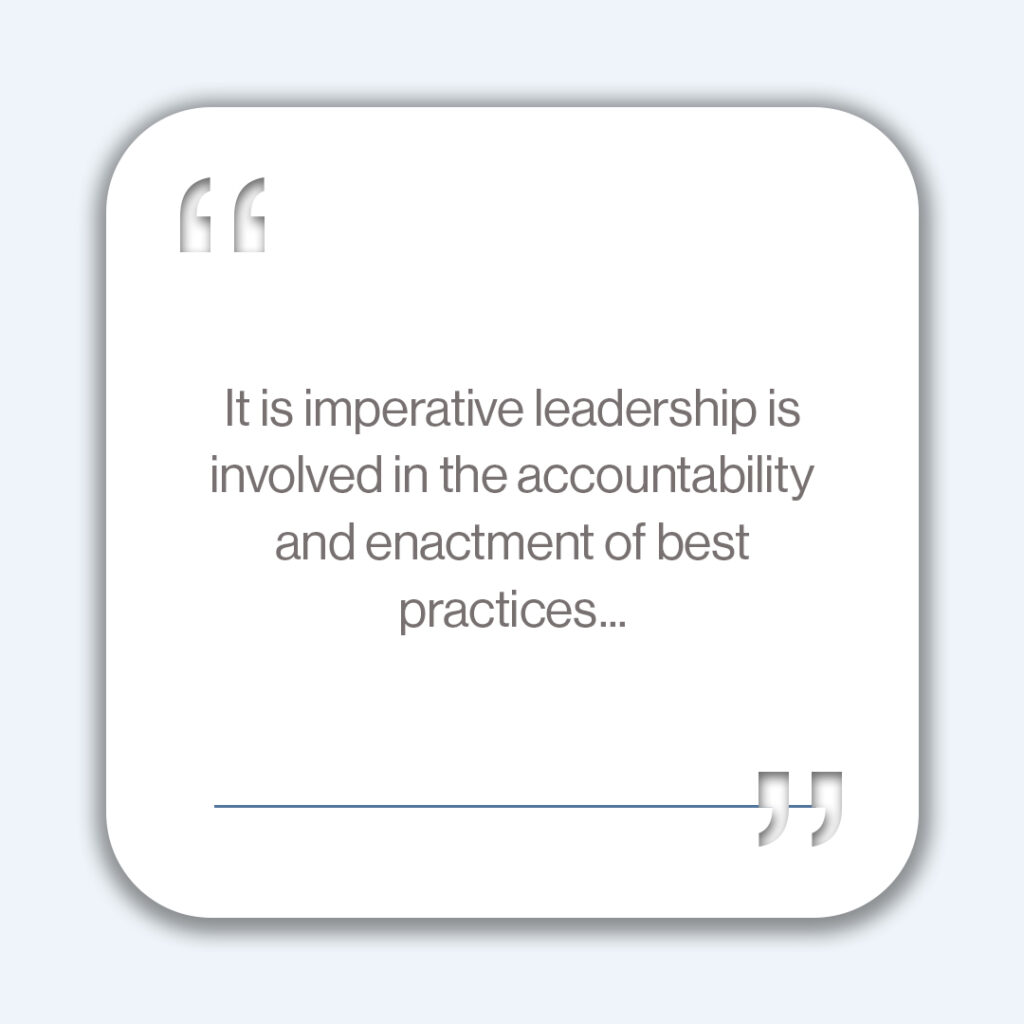
Practices must be more than equal opportunity employment programs, if we are to realize the open exchange and use of divergent ideas (Van Knippenberg et al., 2020). It is imperative leadership is involved in the accountability and enactment of best practices, including “providing diversity training; seeing diversity as a means to achieve company goals; instituting a formal diversity policy; hiring a senior management champion for diversity; and monitoring recruitment, promotion, and pay by gender, race, ethnicity, and disability” (Van Knippenberg et al., 2020; Choi, 2013; Oberfield, 2016). This is not limited to employee-company engagement. Companies that nurture upward mobility programs through community education and engagement – such as Apple’s Apple University and Apple Mentorship Program – further prove their commitment to long-term DEIA change.
Critical to success is how these policies affect the targeted employees, not just what the policies are on paper (Nishii et al., 2017). Policies work best when they are systematically evaluated to find the effectiveness and factors that account for the positive effects, typically using unbiased researchers (Van Knippenberg et al., 2020). It also helps when planning to adopt a practice that organizations map out the specific characteristics needed to create effective policies using interdisciplinary experts (Van Knippenberg et al., 2020). Many organizations struggle with DEIA initiatives that appear transactional in nature, lacking the intentionality and long-term commitment required for a transformational strategic approach. Successful DEIA requires the implementation of a positive diversity climate where practices and standards are intentional, measurable, and become intrinsic to the culture.
#2 Engaging in Dialogue
Success starts with defining what a desirable DEIA culture is for one’s organization and adjusting that definition as stakeholders and society evolve. A recurrent concern from employees is that they are not being listened to or consulted when creating and building their workplace culture. Furthermore, DEIA practices must continually evolve with society, which requires sustained and diligent engagement, seeking new perspectives, and challenging the status quo (Bauer et al., 2022). In other words, there is no true end point but rather it is a continuous process with a positive feedback loop.
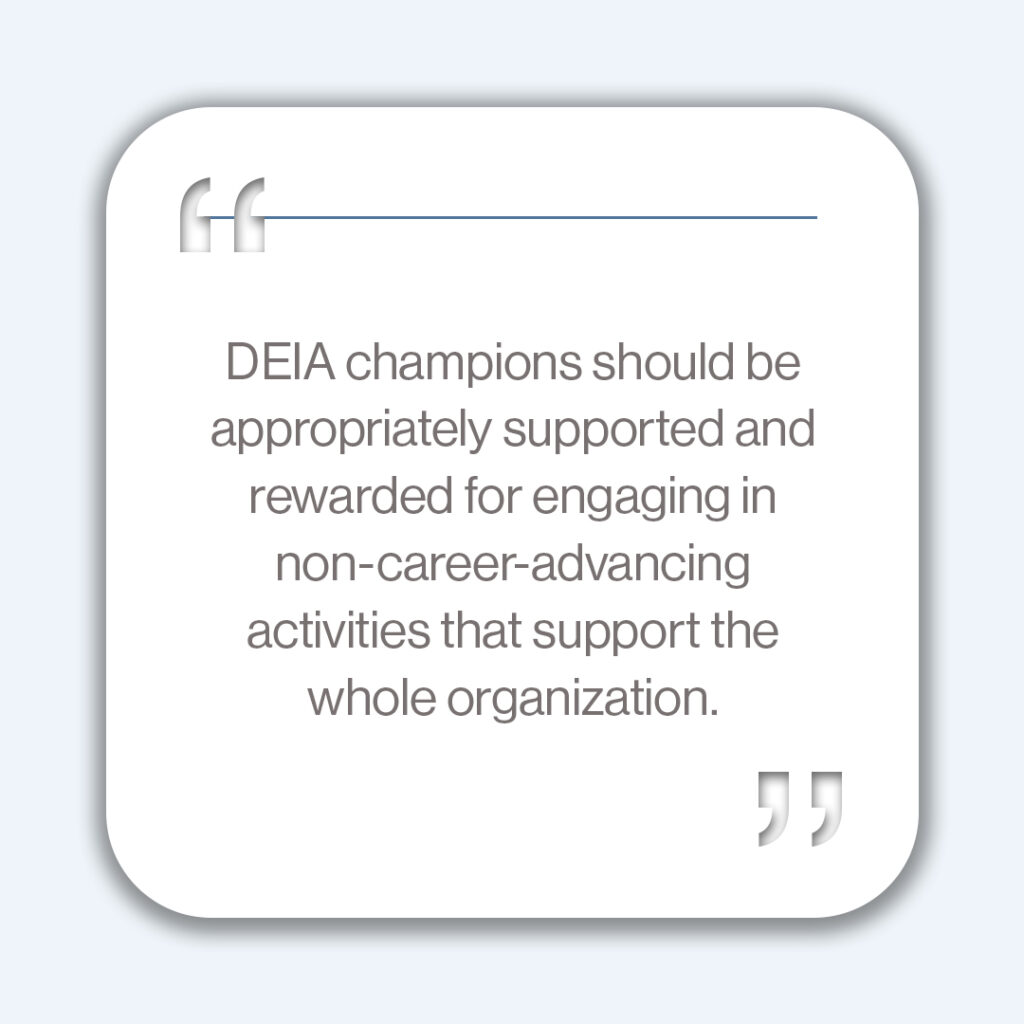
We propose a process for establishing and implementing an organization’s DEIA programs that empowers its stakeholders to establish aligned aspirations and collectively hold themselves accountable to the principles that are affirmed. Stakeholders are communities of employees, customers, service providers, collaborators, leaders, financial backers, and even potential hires – groups who have a vested interest in the overall success of the organization. Within these groups we need DEIA champions who push for positive change within organizations. It is important that such champions are representative of all and that the onus for change does not fall solely on the underrepresented groups. DEIA champions should be appropriately supported and rewarded for engaging in non-career-advancing activities that support the whole organization. This may include appropriate compensation or recognition at all levels of the organization when operationalizing the values and behaviors that create a DEIA environment. With leadership support, DEIA champions can cooperate with one another to create and evaluate DEIA initiatives.
Evaluating and evolving programs and practices requires measurable and actionable outcomes to succeed. Metrics, which we discuss later as a key element of the proposed framework, can also be collectively defined, and tracked by the community. A co-creative process helps embed accountability, which is why it is so critical for DEIA champions to permeate all levels of the organization. Ideally, the process becomes a self-sustaining feedback loop in which policy successes and failures are shared across all facets of an organization with continual improvement of DEIA being the goal.
Arizona State University’s Interplanetary Initiative is advancing a pilot project entitled “Just, Equitable, Diverse, and Inclusive (JEDI) Space” that seeks to embed DEIA dialogue through the creation of a community focused on ensuring open and equitable access to space for all. This project is working toward building a framework for developing a similar DEIA community that may be a useful model for commercial and government space entities alike.
Given that driving DEIA as a mindset and a practice is a process and not an end goal, policies must be continually monitored and updated to ensure their relevance and impact. Any DEIA council or committee of champions should be representative of the wider community they serve. Additionally, the council should be empowered by senior leadership. It is senior leadership who are ultimately responsible for creating an environment where constructive action can occur while retaining the voices of those who will be most affected by policy changes.
#3 Promoting Oversight and Accountability
At least two examples of DEIA committees within the space sector are worthy of note. For example, NASA’s DEIA committee informs, advises, and supports DEIA practices and ensures commitment to DEIA practices among leadership. The committee also coordinates and integrates all the inputs, best practices, and current policies for NASA (NASA, 2022). A similar committee supports the Lunar and Planetary Institute to ensure DEIA is a priority throughout its institutional practices. This committee prioritizes direct feedback and guidance to maintain accountability, while relying on external specialists to eliminate biases. This advisory committee regulates DEIA in all areas, including anything from board meetings to social media and more (Lunar and Planetary Institute, n.d.).
To be effective, a DEIA committee must have a charter with a clear mandate emphasizing a continuous feedback loop, which would include:
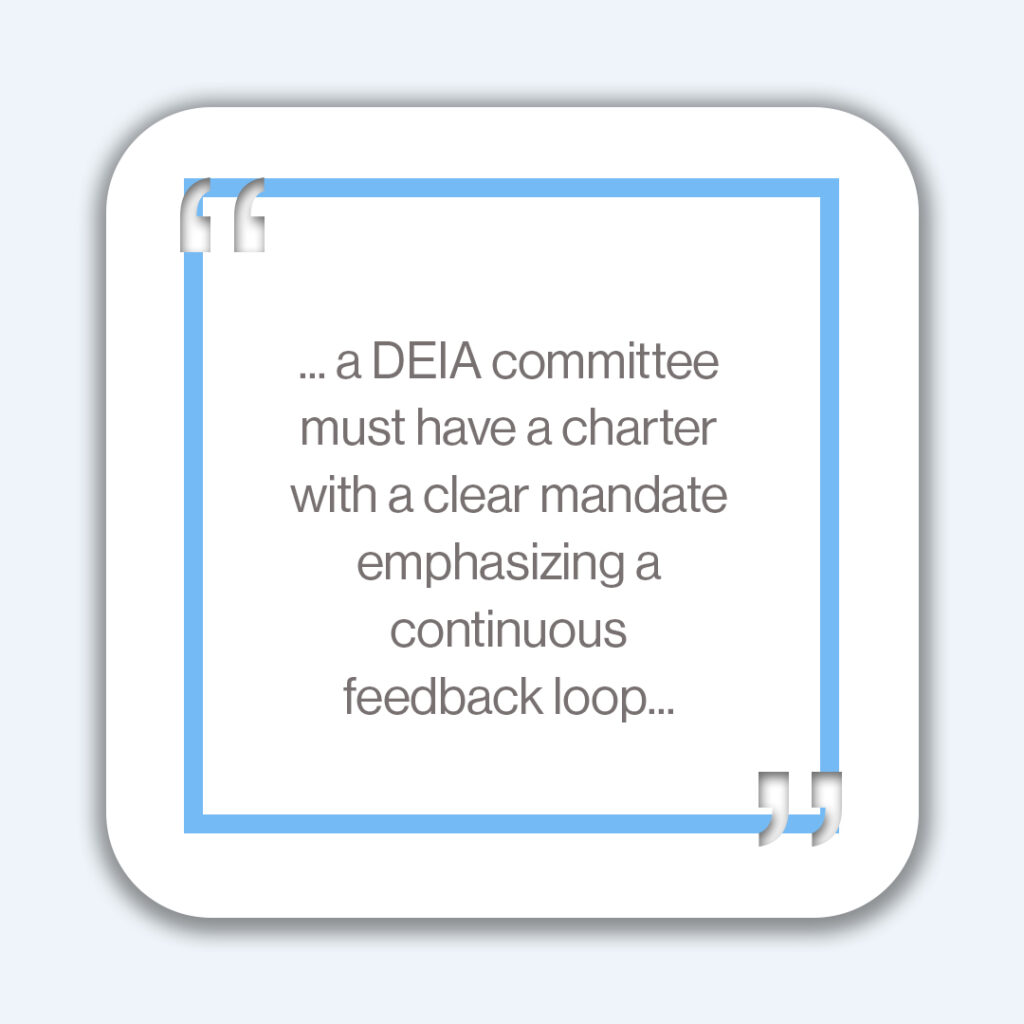
- Establishing DEIA goals for the organization in consultation with a broad set of stakeholders and connecting those goals to the values and performance of the organization with full buy in from the leadership.
- Developing metrics to measure progress toward these goals.
- Monitoring the effectiveness of current practices to ensure they are having the desired effect, and revising DEIA policies, goals and metrics accordingly.
- Ensuring DEIA practices are affecting targeted groups in the intended manner.
- Ensuring DEIA policies are enforced by organizational leadership.
- Reporting consistently and transparently to a broad set of constituents: leadership, internal stakeholders, DEIA champions, and the public.
- Promoting and publishing best DEIA practices across the space sector.
The committee may conduct climate surveys, publish best practices, promote consistency and cohesiveness among stakeholders, train personnel on modern DEIA practices, and provide arbitration to address internal conflicts that lead to equitable resolutions. Committee members should work cooperatively with leadership and be rewarded for their concerted efforts, particularly with successful initiatives or policies. This committee becomes a formal source of knowledge that can be utilized to form the building blocks of diversity, equality, inclusion, and accessibility for a long-term strategy as the space sector grows.
It is important that organizations demonstrate adoption of their DEIA practices throughout their leadership structure. For example, governance boards should include members with expertise in DEIA and members from groups these practices are serving (National Academies of Sciences, Engineering, and Medicine [NASEM], 2022). Buy-in at the top is key. Indeed, leadership involvement in proactive DEIA practices encourages a positive diversity climate (Van Knippenberg et al., 2020), which leads to better hiring and promotion decisions, leading, in turn, to more diversity in managerial roles.
#4 Committing to Transparency and Advocacy
Transparency regarding DEIA practices and goals allows companies to demonstrate their commitment to an inclusive culture, while showing firsthand the growth and realization of the objectives they have developed. This type of transparency goes beyond demographic data by examining intersectionality, proactive practices, and establishing an inclusive and equitable workforce for all definitions of diversity. Even when objectives are unsuccessful, such transparency exemplifies a commitment to constant recursive practices, which are at the core of creating a positive DEIA culture. If a critical mass of organizations is committed to transparency, each member of the constellation can synergize their efforts and accelerate the progression and broad adoption of equitable practices across the industry. As the space industry grows and the number of markets increases, there will be a need for a significant increase in DEIA training and qualified workers to be successful. The space sector is uniquely positioned to pursue these cooperative efforts given the relative newness of the industry and ample opportunity for growth.
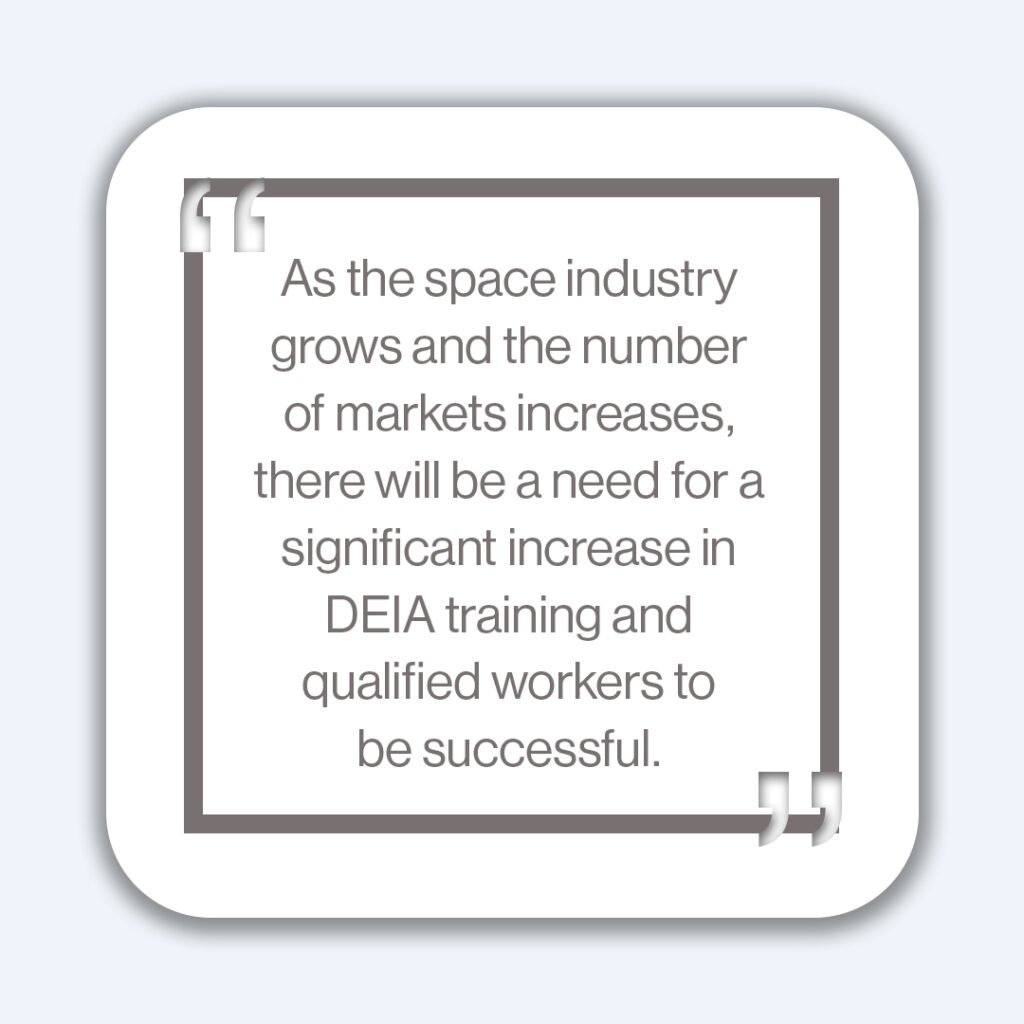
Some organizations within the space industry have already begun to work toward the communal DEIA collaboration as suggested within this paper. The USA Space Technology Expo will host a DEIA booth for the first time in 2023, with the goal of highlighting cross-organization DEIA initiatives (Space Tech Expo, n.d.). In 2022, Hanscom Air Force Base in Lexington, MA, hosted the first command-wide DEIA symposium in hopes of bringing down some of the barriers that impede access to opportunities (Wyatt, 2022). The Aerospace Center for Space Policy and Strategy has held annual DEIA summits since 2021, inviting students from higher education institutions to discuss the future of DEIA in the space workforce (Aerospace Center for Space Policy and Strategy, 2022). We should continue to build upon these types of collaborative experiences, expanding into conferences, coordinated groups, or cross-organizational meetings. Including higher education within these collaborations could become another stream toward encouraging change within the industry from the bottom up.
Beyond sharing insights and best practices at major conferences and in leading journals, we propose that organizations join forces as a collective body within the space sector to establish aligned aspirations and hold each other accountable to the principles that are affirmed. We can establish DEI communities of practice focused on specific pursuits in space, each with its own environments and constraints, such as a lunar base or a commercial space station. Each of these environments will attract a different collection of companies, countries, and individuals all working in shared, unfamiliar, and often unexplored locations.
#5 Adopting the Principles of Universal Design
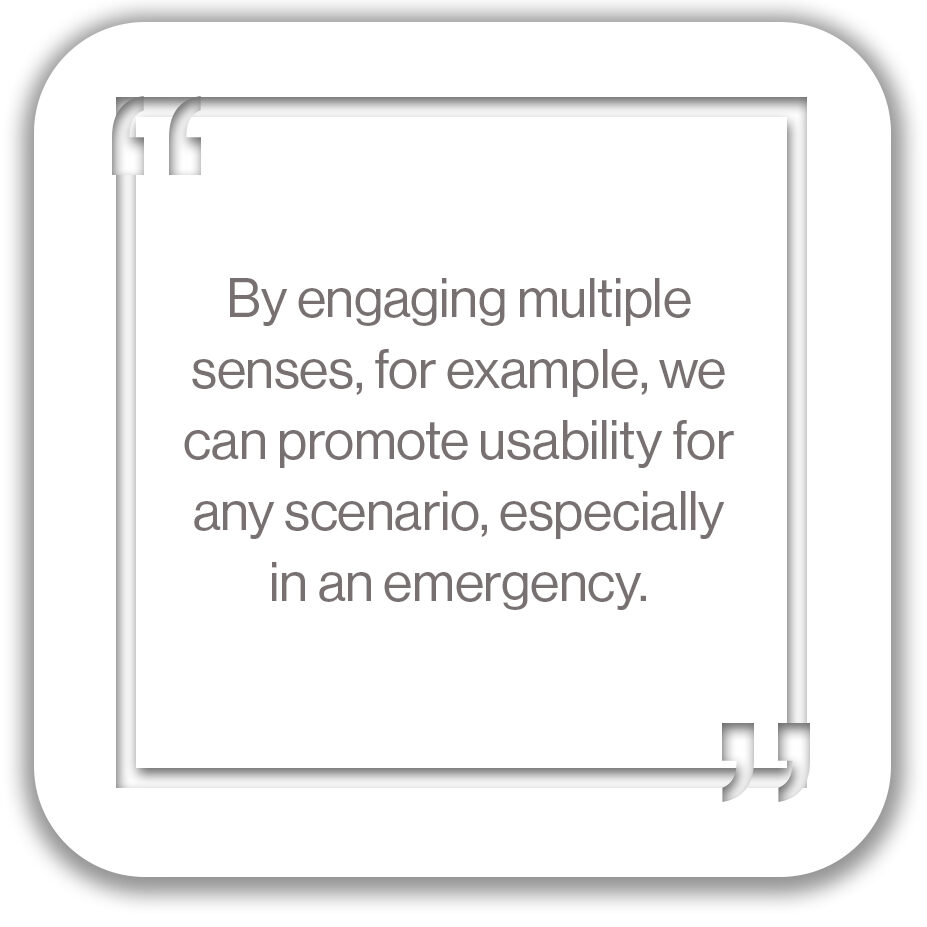
As established in this paper, recognition and implementation of universal design is a mission-critical component to space design that not only creates a larger safety margin, but also allows for greater accessibility to all people and abilities. By engaging multiple senses, for example, we can promote usability for any scenario, especially in an emergency. Creating products and offering services that represent the principles of universal design requires thoughtfulness about the inclusivity of multiple disabilities and human variations. Often this means creating products that engage multiple senses and prioritize ease of use and simplicity.
We can look to the clothing industry as beginning to become representative of universal design in its behaviors and values. For example, American Eagle uses models with disabilities when advertising their clothing, communicating that they are committed to supporting those with disabilities. Space initiatives such as ESA’s parastronaut feasibility project are working toward finding universal design solutions for space hardware using astronauts with disabilities as subjects in test missions (ESA, n.d.).
Adopting the principles of universal design can be an effective way to connect an organization’s DEIA goals and practices to its overall performance and culture as it integrates multiple perspectives into what it does (products and services) and how it does it (behaviors and values) across the markets it serves. CitiGroup’s DEIA programs mentioned earlier exemplify how DEIA can translate directly into an organization’s products and services and, therefore, its bottom line.
#6 Investing in Educational Programs
As underscored in this paper, educational inequities are systemic, multicausal and complex around the world. Most educational systems lack STEM-promoting initiatives, particularly ones that support underrepresented groups. By building on existing programs funded by government agencies and foundations, such as those mentioned in this paper, the space industry has an opportunity to collectively create programs that address the lack of diversity in the pipeline of qualified candidates. Investigating how the industry might collaborate to develop educational and upskilling programs from grade schools and into the collegiate level would be a worthwhile endeavor. Many underrepresented students find that the lack of authentic research opportunities, compounded by the cutthroat mentality in the STEM field, drives them into other academic pathways (NASEM, 2022). However, this is not something that we see across all colleges. In fact, Historically Black Colleges and Universities (HBCUs) and Hispanic Serving Institutions (HSIs) produce the most graduates of color who go on to earn PhDs in STEM (NASEM, 2022). Investing funds into programs that support STEM programs at Minority Serving Institutions (MSIs) and minority engineering programs at majority schools provides a direct line to creating more minority engineers and scientists for the space industry.
By promoting more authentic research opportunities – either as internships or programs at universities that have research opportunities – that encourage cooperative engagement between mentors and students, we could see more students stay within the STEM field long-term. An example of a program that supports diversity in research is MIT’s summer research program (MSRP) that works with students toward creating sustainable intern growth and preparing students to create research papers (MIT, n.d.). (See MIT’s Office of Graduate Education as an example of a program that supports diversity research.) If available, programs should include representative mentors and speakers who are in the same demographic groups as the students involved. Mentors and mentees should also be educated on evidence-based practices that ensure cultural responsiveness and effective communication to be successful (NASEM, 2022). This would eventually lead to an overall increase in the diversity of the workforce pipeline for the space sector.
#7 Tracking and Utilizing Metrics
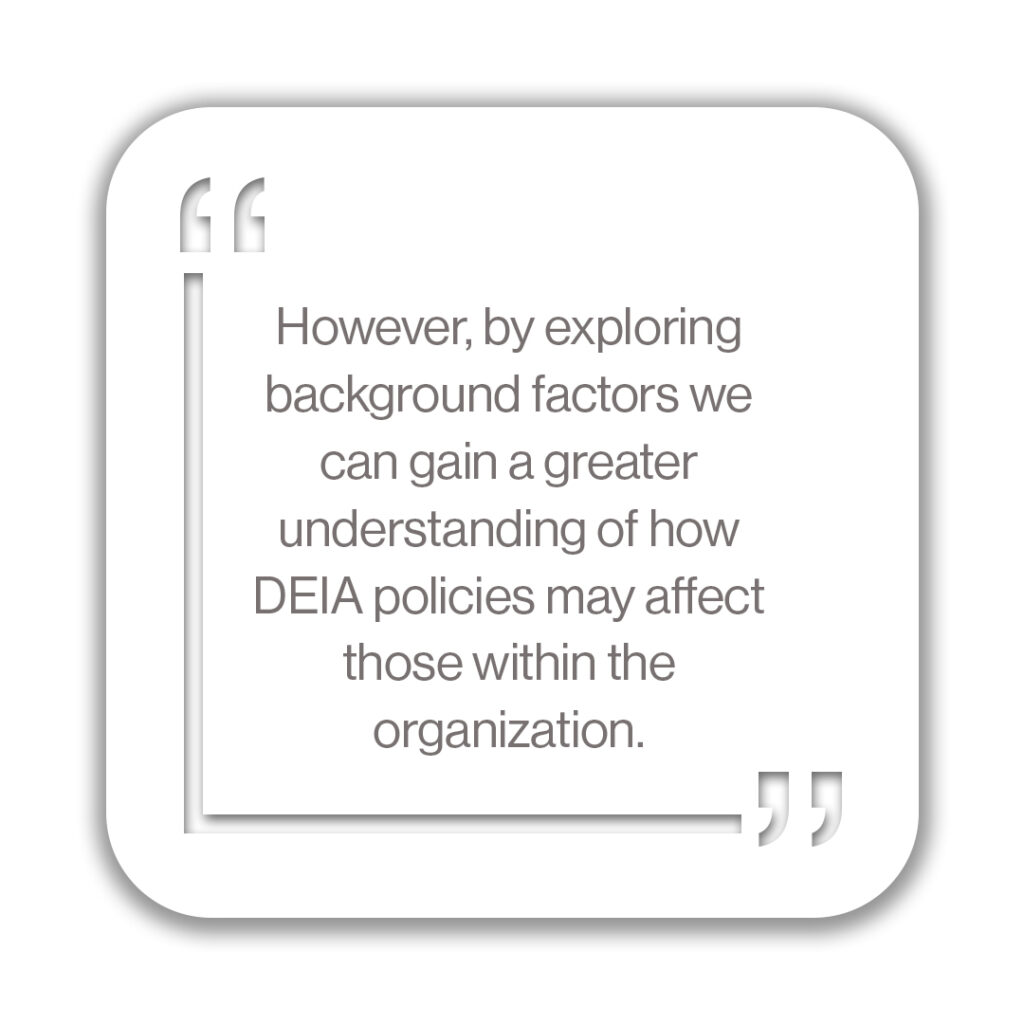
Monitoring diversity and inclusion metrics is a standard and evidence-based procedure for many modern companies and international organizations (Rivera-Valentin et al., 2021; The Science Council, n.d.). The process of measuring diversity indexes, as well as tracking metrics associated with DEIA, allows organizations to identify growth and trends, as well as act proactively if any areas of concern develop. For example, if companies recognize a sudden sharp decrease in employee retention with individuals who identify as LGBTQIA+, that may hint at an internal issue that should be dealt with directly. Or, if trends indicate that hiring practices seem to prefer certain intersectional traits more than others, then attention can be redirected toward evaluating hiring practices. Conversely, if overall data trends remain nominal, resources can be invested elsewhere.
Best practices indicate that ideal metrics include, but are not limited to, age, gender, sex assigned at birth, race, ethnicity, nationality, religious and spiritual beliefs, sexual orientations, socioeconomic status, and pay (Equality and Human Rights Commission, 2022; The Science Council, n.d.). Some of these factors fall outside the “typical” categories associated with DEIA. However, by exploring background factors we can gain a greater understanding of how DEIA policies may affect those within the organization. Diversity goes beyond the common categories protected by the laws of many countries, it includes finding people of differing backgrounds and lived experiences. It is important to appreciate that metrics may differ due to varying privacy laws and cultural norms.
Monitoring these factors not only ensures that companies are hiring and supporting a diverse pool of talent, but also minimizes areas of inequity before they arise. However, it is important to consider when developing data monitoring practices for DEIA that the data itself is not a comprehensive and exact picture of the current DEIA climate. Organizations should not solely rely on diversity targets for adapting their DEIA initiatives and programs. Not all policies and initiatives can be covered through data monitoring, as innumerable factors may impact how the datasets represent the actual diversity within the organization. Often, the intersectionality of one individual will fill several metrics, which may lead to an overrepresentation within the statistical data. Diversity should not rely on a few individuals. Rather it should be an organization-wide effort. Initiatives should still monitor and support employees and organizations directly, while relying on data monitoring to identify changes of statistical significance to target proactively. Relying on datasets exclusively will inevitably create a reactive DEIA policy. Instead, a systematic approach is recommended that combines data collection with direct intervention from DEIA initiatives and programs to support organizations and employees alike.
Conclusion
In this white paper, we discuss DEIA broadly and emphasize that approaches to DEIA need to be proactive rather than reactive. We illustrate how metrics and checklists, while relatively easy to implement, often reflect only a limited view of all stakeholders and their individual lived experiences.
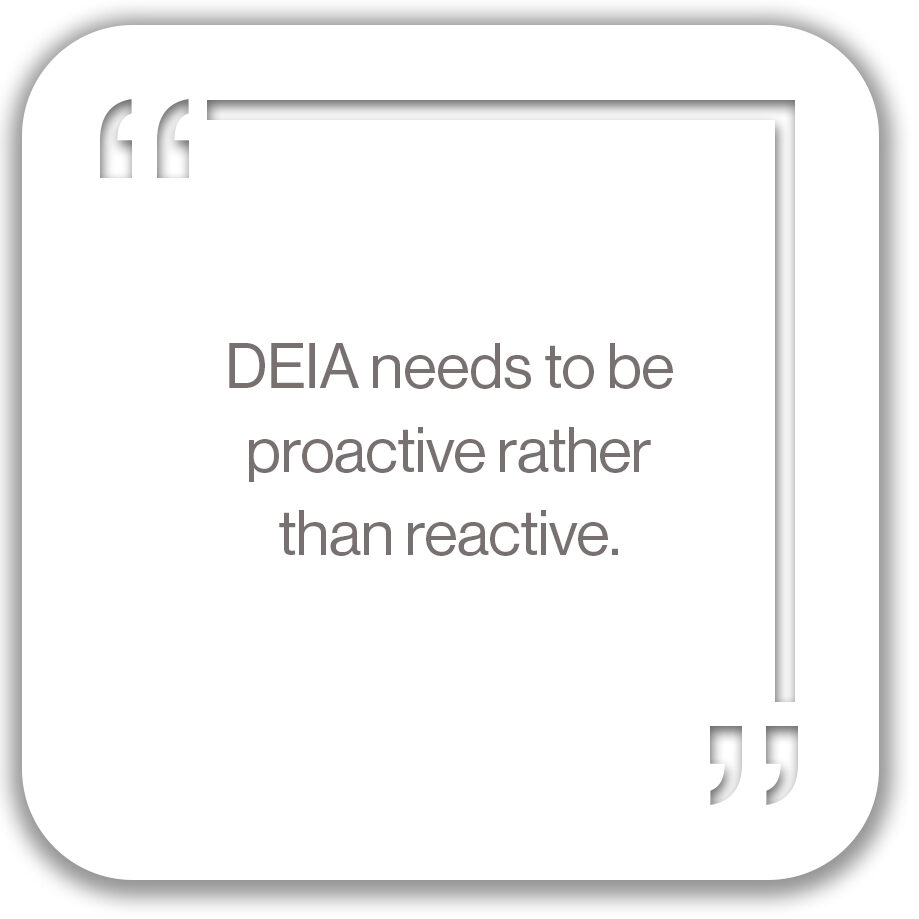
By looking to the progress of companies within the broader economy that stand out in their DEIA approaches, we offer a framework for individual organizations, particularly those in the space sector. We suggest implementing intentional and iterative processes and policies that can effectively advance DEIA culture. We further advocate for individual organizations to collaborate so that DEIA might be embedded more broadly in society – including those communities that will be coexisting for the first time in space.
We note how understanding geopolitical and cultural differences will be essential to this effort. We will need to carefully approach different communities and countries, particularly recognizing differences between both developed/industrialized nations and developing nations. Lastly, we urge all space organizations to address one of the greatest hurdles to creating a DEIA organization and society: the disparities in our educational system, particularly in STEM. We must collectively invest in educational, upskilling, and mentorship programs that will produce the diverse and qualified workforce that is needed to propel the space industry forward and unlock its promise for those of us who remain on Earth and those who travel beyond.